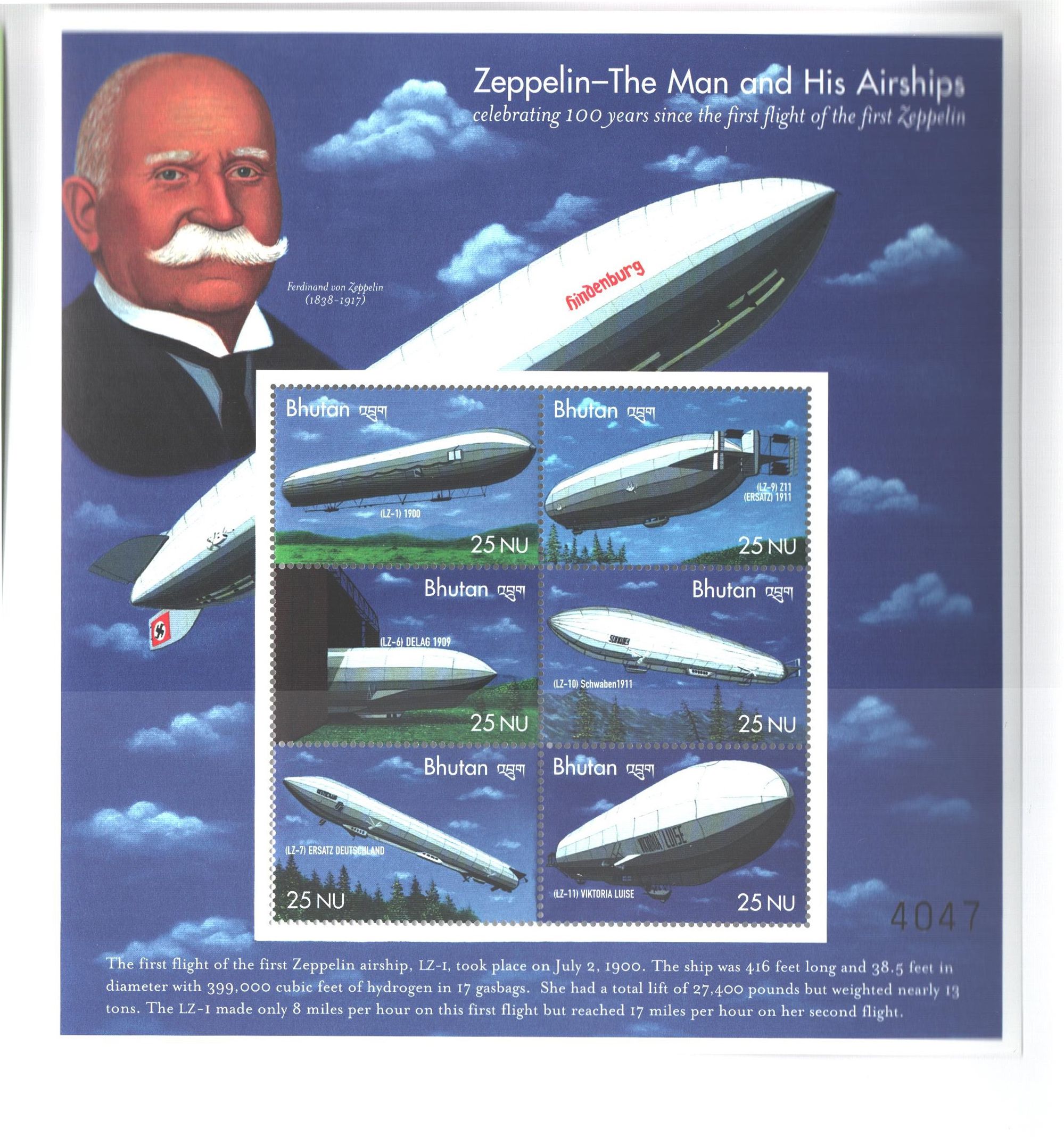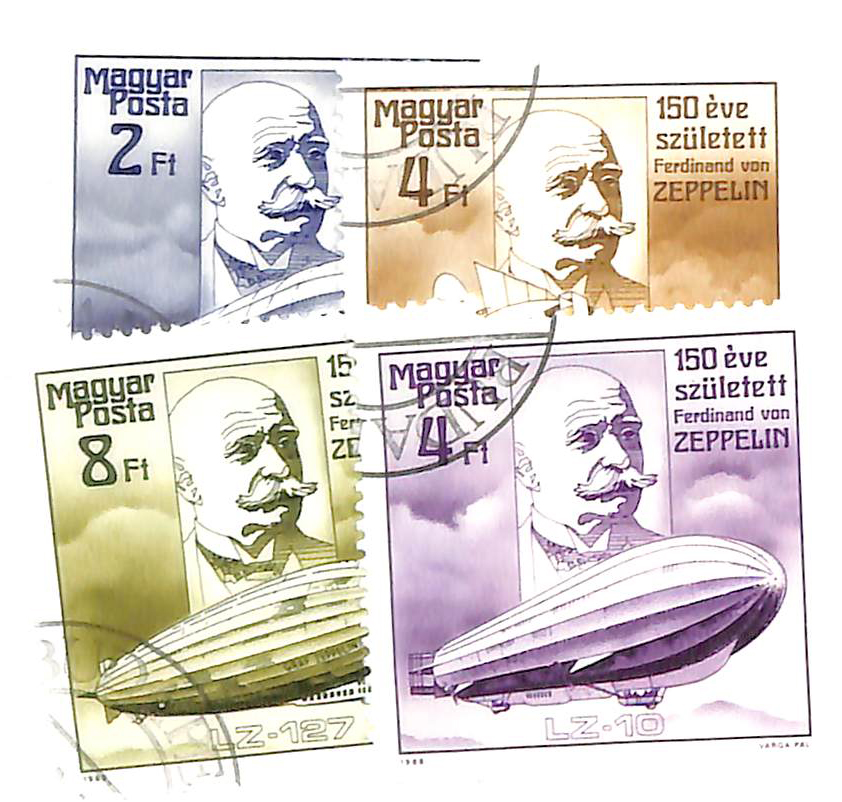
# C13-15 - 1930 Graf Zeppelins, Complete Set of 3
1930 Graf Zeppelin Issue
City: Washington, DC
Quantity: 61,296 to 93,536
Printed By: Bureau of Engraving and Printing
Printing Method: Flat plate printing
Perforations: 11
Ferdinand Von Zeppelin

Ferdinand Adolf Heinrich August Graf von Zeppelin was born on July 8, 1838, in Konstanz, Grand Duchy of Baden (present-day Baden-Württemberg), Germany.
The son of a minister, Zeppelin was raised on his family estate with his brother and sister where they received an education from private tutors. In 1853, he enrolled in a polytechnic institute in Stuttgart.
In 1855, Zeppelin began his military career in the military school at Ludwigsburg. From there, he joined the Army of Württemberg. By 1858, he reached the rank of Lieutenant and was permitted to go on leave to study science, engineering, and chemistry at Tübingen. However, the Austro-Sardinian War broke out while he was away, and he was called back to the military to serve in the Prussian engineering corps.

Zeppelin left the army once again in 1863 to travel to America to serve as an observer for the Union’s Army of the Potomac during the American Civil War. While in America, Zeppelin met Thaddeus SC Lowe of the Balloon Corps. He also traveled to Minnesota, where he met German balloonist John Steiner. On August 19, 1863, Steiner invited Zeppelin on his first balloon ride. Zeppelin would later state that this event inspired his study of dirigible lighter-than-air craft.

Zeppelin returned home and was appointed adjutant of the King of Württemberg in 1865. He served as general staff officer in the Austro-Prussian War of 1866 and received the Knight’s Cross of the Order of Distinguished Service. During the Franco Prussian War a few years later, he went on a dangerous reconnaissance mission behind enemy lines during which he was nearly captured. The event brought him considerable fame in Germany.

During his military service, Zeppelin continued to pursue his interest in flight. As early as March 1874, he wrote some of his ideas for large airships. After visiting a lecture on World Postal Services and Air Travel, he developed the basic idea of his craft – a large, rigidly framed ship carrying several gasbags. After learning about the success of a French Army airship, Zeppelin proposed that Germany follow suit with their military. He eventually resigned from the military in 1891, after which, he devoted all of his energy to airships.

Zeppelin hired an engineer and eventually his idea evolved into a rigid aluminum craft covered in fabric with several gas cells. He first published his idea in March 1892 and submitted his pans to the Prussian Airship Service. They initially authorized the funds for the project, but later withdrew their offer and rejected the design. In 1896, Zeppelin gave a lecture for the Association of German Engineers on his steerable airship designs. They were so impressed, they launched a public campaign to raise money for him and he eventually got the backing he needed to move forward.

Zeppelin launched his first airship, the LZ1 on July 2, 1900. The ship remained in the air for 20 minutes but was damaged upon landing. Though he staged two more flights, the ship wasn’t considered a success so Zeppelin began working on the LZ2. That craft only made one flight and Zeppelin then set to working on the LZ3 in May 1906. While the LZ3 fared better than the previous ships, it wouldn’t withstand a 24-hour flight trial, so Zeppelin began work on the LZ4. The LZ4 had been a success and aroused public interest, but it was completely destroyed during a storm. Zeppelin then repaired and improved the LZ3, which had also been damaged during a storm, and it was officially accepted by the government in 1908.

Over the years, Zeppelin’s relationship with the military was strained and his company began producing Zeppelins for passenger service. Zeppelin died on March 8, 1917. His company continued on after his passing and Zeppelins experienced a resurgence in popularity, particularly during the 1920s and 1930s with a series of high-profile flights around the world.
Click here for more Zeppelin and balloon stamps.
1930 Graf Zeppelin Issue
City: Washington, DC
Quantity: 61,296 to 93,536
Printed By: Bureau of Engraving and Printing
Printing Method: Flat plate printing
Perforations: 11
Ferdinand Von Zeppelin

Ferdinand Adolf Heinrich August Graf von Zeppelin was born on July 8, 1838, in Konstanz, Grand Duchy of Baden (present-day Baden-Württemberg), Germany.
The son of a minister, Zeppelin was raised on his family estate with his brother and sister where they received an education from private tutors. In 1853, he enrolled in a polytechnic institute in Stuttgart.
In 1855, Zeppelin began his military career in the military school at Ludwigsburg. From there, he joined the Army of Württemberg. By 1858, he reached the rank of Lieutenant and was permitted to go on leave to study science, engineering, and chemistry at Tübingen. However, the Austro-Sardinian War broke out while he was away, and he was called back to the military to serve in the Prussian engineering corps.

Zeppelin left the army once again in 1863 to travel to America to serve as an observer for the Union’s Army of the Potomac during the American Civil War. While in America, Zeppelin met Thaddeus SC Lowe of the Balloon Corps. He also traveled to Minnesota, where he met German balloonist John Steiner. On August 19, 1863, Steiner invited Zeppelin on his first balloon ride. Zeppelin would later state that this event inspired his study of dirigible lighter-than-air craft.

Zeppelin returned home and was appointed adjutant of the King of Württemberg in 1865. He served as general staff officer in the Austro-Prussian War of 1866 and received the Knight’s Cross of the Order of Distinguished Service. During the Franco Prussian War a few years later, he went on a dangerous reconnaissance mission behind enemy lines during which he was nearly captured. The event brought him considerable fame in Germany.

During his military service, Zeppelin continued to pursue his interest in flight. As early as March 1874, he wrote some of his ideas for large airships. After visiting a lecture on World Postal Services and Air Travel, he developed the basic idea of his craft – a large, rigidly framed ship carrying several gasbags. After learning about the success of a French Army airship, Zeppelin proposed that Germany follow suit with their military. He eventually resigned from the military in 1891, after which, he devoted all of his energy to airships.

Zeppelin hired an engineer and eventually his idea evolved into a rigid aluminum craft covered in fabric with several gas cells. He first published his idea in March 1892 and submitted his pans to the Prussian Airship Service. They initially authorized the funds for the project, but later withdrew their offer and rejected the design. In 1896, Zeppelin gave a lecture for the Association of German Engineers on his steerable airship designs. They were so impressed, they launched a public campaign to raise money for him and he eventually got the backing he needed to move forward.

Zeppelin launched his first airship, the LZ1 on July 2, 1900. The ship remained in the air for 20 minutes but was damaged upon landing. Though he staged two more flights, the ship wasn’t considered a success so Zeppelin began working on the LZ2. That craft only made one flight and Zeppelin then set to working on the LZ3 in May 1906. While the LZ3 fared better than the previous ships, it wouldn’t withstand a 24-hour flight trial, so Zeppelin began work on the LZ4. The LZ4 had been a success and aroused public interest, but it was completely destroyed during a storm. Zeppelin then repaired and improved the LZ3, which had also been damaged during a storm, and it was officially accepted by the government in 1908.

Over the years, Zeppelin’s relationship with the military was strained and his company began producing Zeppelins for passenger service. Zeppelin died on March 8, 1917. His company continued on after his passing and Zeppelins experienced a resurgence in popularity, particularly during the 1920s and 1930s with a series of high-profile flights around the world.
Click here for more Zeppelin and balloon stamps.











